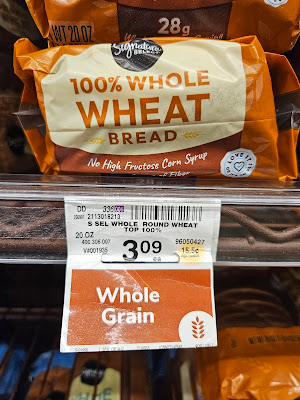Do me now!
Do me here!
I do allow!
[Note: You may have noticed that there are a lot of 2 or 3 lines posts about money. I’m not cheap, but I am frugal – I pay close attention to even relatively insignificant expenditures. For example, I expend quite a bit of time and effort minimizing how much money I spend on gas for my car. And I worry about spending a dollar more for a loaf of sandwich bread – which I purchase only once or twice a month. All this is obviously indicative of some deep-seated psychological issues resulting from my being the oldest child of exceedingly frugal parents.]
I do most of my grocery shopping at either Safeway or Harris-Teeter.
A 20-ounce loaf of Safeway’s store brand of whole wheat bread costs $3.09 at every Safeway in my area:
 |
A 20-ounce loaf of Harris-Teeter’s store brand of whole wheat bread costs $1.99 at every Harris-Teeter in my area:
 |
I’ve eaten both brands of bread, and they are essentially identical – same taste, same texture, same color, same shape . . . same everything.
So how can Safeway get away with charging over a dollar more for its bread than Harris-Teeter charges for its bread?
* * * * *
“Price dispersion” is the term economists use when prices charged by different sellers for the same item vary. (Technically, Safeway bread is not the same product as Harris-Teeter bread. But as I said above, the two different brands are essentially identical.)
Price dispersion is usually attributed to the existence of consumer search costs. For example, if there were significantly more Safeway stores in my area, it wouldn’t be surprising if Safeway’s prices were at least somewhat higher – after all, it wouldn’t be worth driving to a Harris-Teeter store that was significantly further away just to save a buck on bread.
There are more Safeway stores than Harris-Teeter stores in my county. But you don’t have to drive that far to get to a Harris-Teeter store.
And my impression is that it’s usually six of one, half a dozen of the other when it comes to which store has the lower price on the other groceries that I buy the most often. So it’s a bit of a mystery why there is persistent price dispersion when it comes to store-brand whole wheat bread.
* * * * *
In case you’re wondering, here are the ten grocery items I purchase the most frequently (in alphabetical order):
– Amy’s Organic quinoa, kale, and red lentil soup
– Campbell’s “Homestyle” chicken noodle soup. (It’s my go-to when I have nothing else for dinner.)
– Dr. Pepper. (I refuse to pay the regular price for Dr. Pepper – I only buy it if it being sold at a significant price reduction. That’s not so much to save money as it is to limit my consumption of the stuff.)
– Eggs. (White or brown, extra-large or jumbo – it don’t make no never-mind to me, as long as it’s on sale.)
– French-style green beans. (In my experience, the Safeway’s French-style green beans are much better than Harris-Teeter’s.)
– Italian salad dressing. (I don’t particularly care whether I have Ken’s, or Kraft, or Paul Newman’s, or Wishbone – one of them is usually on sale.)
 |
| Whatever is on sale |
– Land O’Lakes butter with sea salt and olive oil. (That’s mostly to slather on my French-style green beans.)
– Extra-sharp cheddar cheese. (Cabot and Tillamook are much better than the store brands, although more expensive – but they go on sale fairly often.)
– Utz potato chips. (I buy a box of ten one-ounce bags and have one bag each time I eat a sandwich. In theory, it would be much more economical to buy one large bag rather than ten small ones – but if I bought a large bag, I wouldn’t limit myself to one-ounce servings per meal.)
– Wild-caught salmon. (I eat wild-caught salmon two or three times each week, regardless of the price – I’m worth it!)
* * * * *
The Red Hot Chili Peppers’ Blood Sugar Sex Magik was one of the first two CDs I bought when I was given a CD player for Christmas in 1991. (The Beach Boys’ Pet Sounds was the other one.)
I wanted Blood Sugar Sex Magik because it included “Give It Away,” which still gets me all riled up when I hear it. But “Suck My Kiss” is just as good – maybe even better.
I heard “Suck My Kiss” on the radio when I was driving around today with my 7-year-old and 4-year-old grandsons. We had previously heard “Yummy Yummy Yummy” and “1, 2, 3 Red Light,” which are much more suitable for young ears – but I couldn’t bring myself to tune away from “Suck My Kiss” when it came on. If that makes me a bad grandfather, so be it.
Click here to watch the official music video for “Suck My Kiss.”
Click here to buy “Suck My Kiss” from Amazon.










